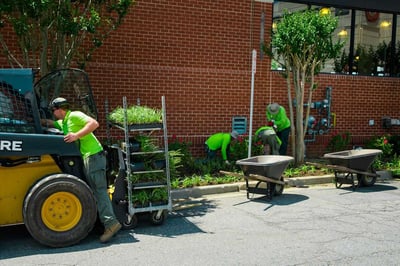 If we do our job right, the plants we add to your property look like they’ve always been there, like they perfectly belong.
If we do our job right, the plants we add to your property look like they’ve always been there, like they perfectly belong.
But of course, first they came from somewhere else.
We need thousands and thousands of plants, from flats of annuals to potted tropicals to bare root saplings to big established trees.
Where do landscapers get their plants?
Brad Butler, corporate manager at Level Green Landscaping, gives us a behind-the-scenes look.
Some Are Closer Than You Think
The flats of colorful annual flowers we use to brighten up your property are often grown close to home at several of our trusted growers.
We have strong relationships with these partners, who often grow annuals specifically for us after we tell them our needs.
The flats of flowers and plants arrive on big box trucks to our yard, where they spend no more than a day in our holding area before we truck them to our customers’ properties.
Traveling Tropicals
Exotic banana trees, palms and canna offer a vacation vibe and make a big statement in oversized pots.
We love them. But you might have noticed Maryland isn’t exactly a balmy rain forest.
So we figure out how many tropical beauties our customers need and then place one huge order to our supplier in Florida.
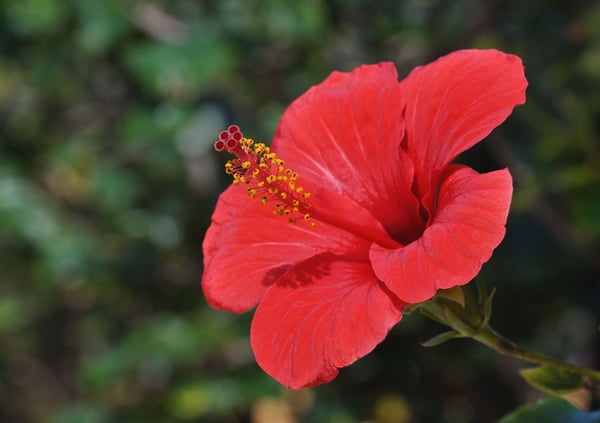
They all arrive at once, turning our holding area into a giant tropical paradise before our various branches claim their plants and deliver them to our customers.
Trees, Please
On a large construction job, like a shopping center, we might need 20 or more trees. Sometimes they come from trusted growers out of state.
Certain areas of the country are known for growing plants, Butler says, including Tennessee and the Carolinas.
“Oregon has some really beautiful stuff,” he says.
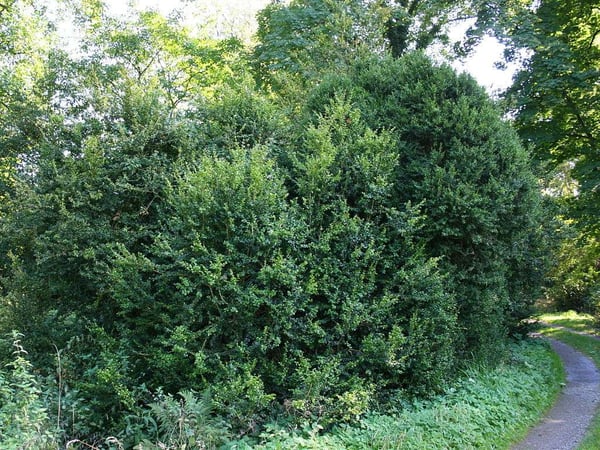
Many of our evergreens and conifers come from Oregon, where the cool and rainy weather is great for growing stunners like Japanese cedar or Golden Dwarf Hinoki cypress.
The cost to ship a few majestic trees across the country is prohibitive, Butler says.
But reputable local nurseries might have hundreds shipped in and we happily buy from them.
That’s Right — 15,000 Liriope
Some of our customers have huge properties. Five potted ornamental grasses just won’t cut it.
That’s when contract growing comes in handy.
“If we know ahead of time that we need 15,000 liriope for a big construction job, we talk to a grower a year before so they can have them ready for us,” Butler says.
The grower is happy for the business, and we know we’ll get exactly what we need for our customer.
“Relationships are important,” he says. “We support them and they support us.
“A lot of times if I call a vendor and they don’t have what we need, they know somebody who does.”
We’re Picky — Here’s Why
We don’t buy our plants from just anybody. Quality is key.
The best growers make sure conditions are just right for prime plants.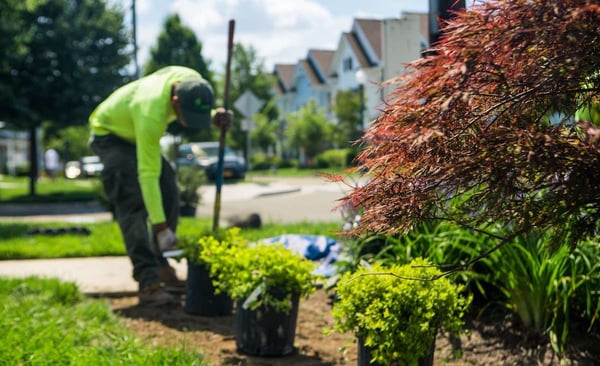
“A plant can go bad for a lot of reasons, ” Butler says. “Maybe it doesn’t have the right nutrients in the soil. Or it didn’t get enough water. Or it was planted at the wrong time of year.”
If your plants look a bit droopy right after we plant them, don’t worry.
“Sometimes they look worse before they’ll look better,” Butler says.
Plants often go into shock when they’re first planted, and look kind of limp, but it doesn’t mean they’re dying. It’s hard work being planted. They’ll perk up.
Oops
Choosing just the right plant for each spot isn’t an exact science.
“A river birch likes wet soil, but maybe it has a fungus problem,” Butler says.
Sometimes a plant just barely works for our growing zone.
“Crape myrtles are popular around here, but a couple varieties won’t make it through a couple harsh winters,” Butler says. “We steer customers to other hardier varieties.”
People love Knock Out roses, but lately they’ve been infected with rose rosette, a virus that’s slowly taking over even roses that have been bred to be disease resistant, like the Knock Out variety. An infected plant can die within a couple years.
“Sometimes a plant just doesn’t work in a situation,” Butler says. “The grower can suggest something different, or we can do our research and come up with something that will work better.”
The Ripple Effect
We choose the best, healthiest, most attractive plants so that you, our customers, love them.
You want the best plants so that your customers love them.
“The finished product is what our customers buy,” Butler says. “We might be planting something for a purpose, to screen off an area or to stop erosion. But customers usually want plants for curb appeal. They have to look and be healthy.”
Sometimes that takes a bit of a crystal ball — and knowing we buy our plants from the best.
“When we plant something in March, it might not look like much,” Butler says. “But if it has a healthy root system and is covered in buds, we know it will look great.
“It’s about the long term,” he says. “If you plant a four-foot evergreen that’s sub par, the customer is looking forward to what it will look like when it gets to be 10 or 15 feet. But if the quality isn’t there, it might not ever get to that stage. That’s a lot of wasted time.
“They paid for something to look a certain way, but the plant won’t make that impact.”
Trust Level Green For Top Quality Plants
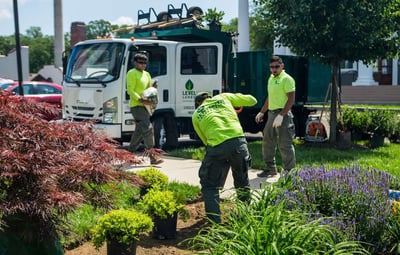 Your reputation depends on having beautiful, healthy plants that impress.
Your reputation depends on having beautiful, healthy plants that impress.
So does ours.
Where do landscapers get their plants?
We can’t speak for other landscapers, but here at Level Green, we only buy our plants from trusted sources who care about plant quality as much as we do.
If you’re not already a Level Green Landscaping client, we’d love to add you to our growing list of happy customers. Our focus is on commercial properties like offices, mixed-use sites, HOAs, municipalities and institutions in Maryland, Washington DC and Northern Virginia.
Contact us at 202-544-0968. You can also request a free consultation online to meet with us one-on-one.
We’d love to hear from you.


